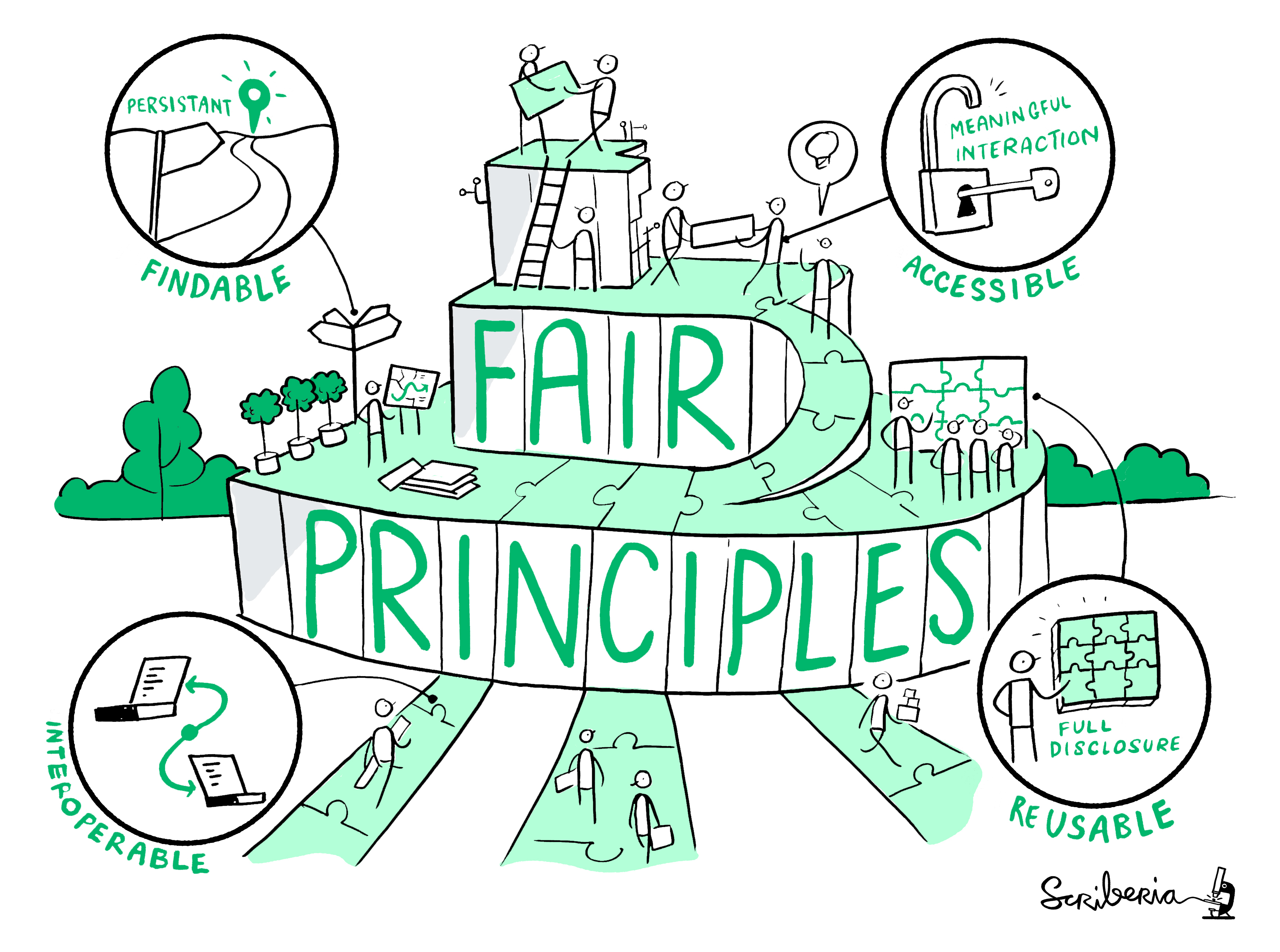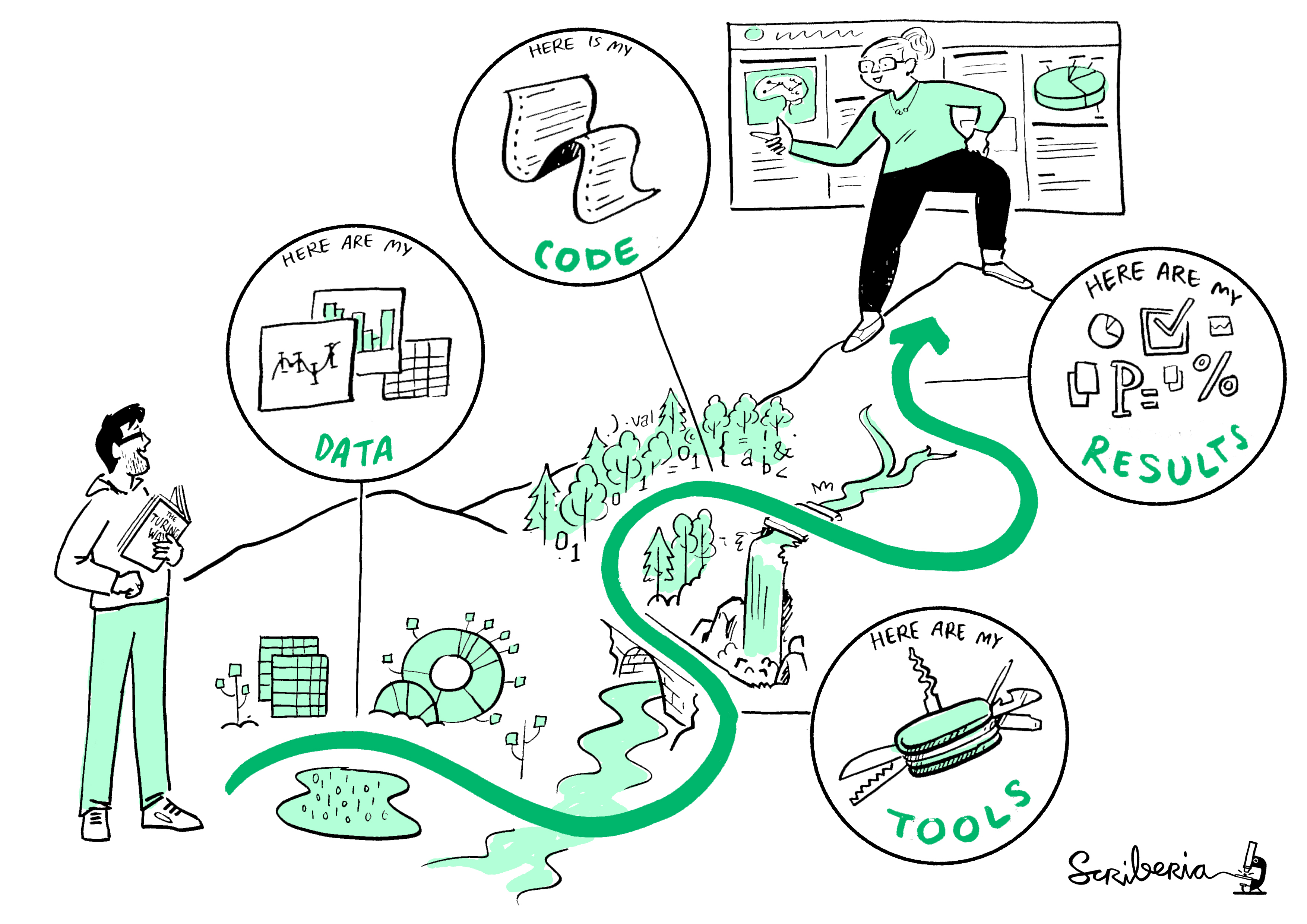Introduction
Overview
Teaching: 5 min
Exercises: 10 minQuestions
What are the FAIR principles?
Why should I care to be FAIR?
How do I get started?
Objectives
Identify the FAIR principles
Recognize the importance of moving towards FAIR in research
Relate the components of this lesson to the FAIR principles
What is FAIR?
The FAIR principles for research data, originally published in a 2016 Nature paper, are intended as “a guideline for those wishing to enhance the reusability of their data holdings.” This guideline has subsequently been endorsed by working groups, funding bodies and institutions.
FAIR is an acronym for Findable, Accessible, Interoperable, Reusable.
- Findable: others (both human and machines) can discover the data
- Accessible: others can access the data
- Interoperable: the data can easily be used by machines or in data analysis workflows.
- Re-usable: the data can easily be used by others for new research
The FAIR principles have a strong focus on “machine-actionability”. This means that the data should be easily readable by computers (and not only by humans). This is particularly relevant for working with and discovering new data.
What the FAIR principles are not
A standard: The FAIR principles need to be adopted and followed as much as possible by considering the research practices in your field.
All or nothing: making a dataset (more) FAIR can be done in small, incremental steps.
Open data: FAIR data does not necessarily mean openly available. For example, some data cannot be shared openly because of privacy considerations. As a rule of thumb, data should be “as open as possible, as closed as necessary.”
Tied to a particular technology or tool. There might be different tools that enable FAIR data within different disciplines or research workflows.
 This
image was created by Scriberia for The Turing Way community and is used under a
CC-BY licence. Source: https://doi.org/10.5281/zenodo.3695300
This
image was created by Scriberia for The Turing Way community and is used under a
CC-BY licence. Source: https://doi.org/10.5281/zenodo.3695300
Discuss the different principles
Read the summary table of the 15 FAIR principles in Wilkinson et al. (See “Box 2: The FAIR Guiding Principles”). After reading this, answer the following questions:
- Are there any terms that you are unfamiliar with?
- Are there any principles that you could implement right away?
- What do you think would be the most challenging principle to implement?
Why FAIR?
The original authors of the FAIR principles had a strong focus on enhancing reusability of data. This ambition is embedded in a broader view on knowledge creation and scientific exchange. If research data are easily discoverable and re-usable, this lowers the barriers to repeat, verify, and build upon previous work. The authors also state that this vision applies not just to data, but to all aspects of the research process. This is visualized in the image below.
 This
image was created by Scriberia for The Turing Way community and is used under a
CC-BY licence. Source: https://doi.org/10.5281/zenodo.3695300
This
image was created by Scriberia for The Turing Way community and is used under a
CC-BY licence. Source: https://doi.org/10.5281/zenodo.3695300
What’s in it for you?
FAIR data sounds like a lot of work. Is it worth it? Here are some of the benefits:
- Funder requirements
- It makes your work more visible
- Increase the reproducibility of your work
- If others can use it easily, you will get cited more often
- You can create more impact if it’s easier for others to use your data
- …
Getting started with FAIR (climate) data
As mentioned above, the FAIR principles are intended as guidelines to increase the reusability of research data. However, how they are applied in practice depends very much on the domain and the specific use case at hand.
For the domain of climate sciences, some standards have already been developed that you can use right away. In fact, you might already be using some of them without realizing it. NetCDF files, for example, already implement some of the FAIR principles around data modeling. But sometimes you need to find your own way.
This tutorial contains six thematic episodes that cover the basic steps to making data FAIR. We will explain how these topics relate to the FAIR principles, what you can already do today, and where appropriate, we will point out existing standards for climate data.
The episodes are:
- Documentation: helps to make data reusable, especially for humans
- Metadata: similar to documentation, although typically more structured and standardized
- Data formats: highly relevant for interoperability and long-term preservation of data
- Data access: data repositories as well as software can greatly increase data access and findability
- Identifiers: very important for reproducibility, but also for data access and findability
- Licences: well chosen licences facilitate re-use and make sure you get the credits you deserve (if you so desire)
Evaluate one of your own datasets
Pick one dataset that you’ve created or worked with recently, and answer the following questions:
- If somebody gets this dataset from you, would they be able to understand the structure and content without asking you?
- Do you know who has access to this dataset? Could somebody easily have access to this dataset? How?
- Does this dataset needs proprietary software to be used?
- Does this dataset have a persistent identifier or usage licence?
Further reading
- Wilkinson et al. (2016) The FAIR Guiding Principles for scientific data management and stewardship. doi:10.1038/sdata.2016.18
- Mons et al. (2017) Cloudy, increasingly FAIR; revisiting the FAIR Data guiding principles for the European Open Science Cloud. doi:10.3233/ISU-170824
- FORCE11
- GO FAIR initiative
- EU H2020 Guidelines on FAIR Data Management
Key Points
The FAIR principles state that data should be Findable, Accessible, Interoperable, and Reusable.
FAIR data enhance impact, reuse, and transparancy of research.
FAIRification is an ongoing effort accross many different fields.
FAIR principles are a set of guiding principles, not rules or standards.